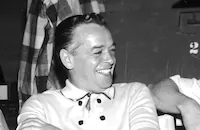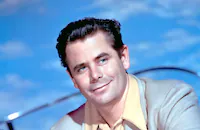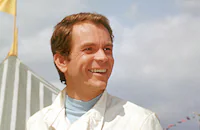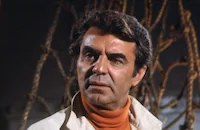Torpedo Run

Brief Synopsis
Cast & Crew
Joseph Pevney
Glenn Ford
Ernest Borgnine
Diane Brewster
Dean Jones
L. Q. Jones
Film Details
Technical Specs

Synopsis
In the South Pacific in 1942, U.S. Lt. Cmdr. Barney Doyle and the crew of the submarine Greyfish take part in an intensive hunt for the Japanese battle ship Shinaru , which led the attack on Pearl Harbor. In addition to the tensions brought about by the search, Barney is anxious for news on the disposition of his wife Jane and young daughter Dee Dee, who stayed in Manila after the invasion of the Philippines by the Japanese. Barney is plagued with guilt that he did not insist on sending Jane stateside when she demanded that the family remain together in the South Pacific. After the Greyfish successfully attacks a Japanese destroyer, Barney and his executive officer, Lt. Archer Sloan, receive news from the head of the Pacific Submarine Fleet, Adm. Samuel Setton, that all the Americans in the Philippines have been safely transferred as prisoners of war from Manila. The good news is short-lived, however, as Setton later forwards news that the Shinaru is reported to be returning to Tokyo Bay, with a defensive escort that includes the transport ship carrying the American POWs, including Jane and Dee Dee. As the submarine nearest to Tokyo Bay, the Greyfish is assigned to attack. Suspecting that the Shinaru intends to use the transport as a protective screen, Arch tries to dissuade Barney from going ahead with the mission, but Barney declares that he has no choice. When the Greyfish sights the convoy escorting the Shinaru , Barney begins his attack, after which the POW transport places itself between the Greyfish and the Shinaru . Arch pleads with Barney not to risk killing Jane and Dee Dee, but Barney proceeds with the attack. Although Barney attempts to fire underneath the transport, the torpedoes hit the ship, which then breaks up. Barney and Arch watch in dismay as the Japanese allow the survivors to thrash about, hoping to lure the Greyfish to the surface to rescue them. After Barney orders evasive action, the Greyfish departs for safe waters. Later, the Greyfish is summoned back to Pearl Harbor, but Barney refuses to return, pointing out that the ship still has sixteen unused torpedoes. In spite of Arch's uncertainty about continuing, Barney orders the Greyfish to trail the Shinaru at a safe distance. After the Shinaru and remnants of the convoy enter Tokyo Bay, Barney fires upon a tug pulling a protective webbing to enclose the harbor and uses the distraction of the sinking tug to slip into the bay. A Japanese destroyer detects the Greyfish in the bay, but Barney keeps the submarine precariously hidden in a mine field, and when the destroyer follows the submarine it is blown up. Barney then navigates the Greyfish through the mine field for a shot at the Shinaru , but its protective screen again places another ship between the submarine and its objective. After a second destroyer sets out in pursuit of the Greyfish , Barney pilots his ship back into the mine field for protection. Following the suggestion of Lt. Redley, a British officer stationed aboard the submarine, Barney detonates several mines to make the Japanese believe the Greyfish has been destroyed. When the destroyer returns to the harbor, Barney blows a hole in the protective webbing with the last of his torpedoes, enabling the Greyfish to escape. Exhausted, Barney orders the ship back to Pearl Harbor, then retires to his quarters where he sleeps for three days. Upon awakening, Barney asks Arch if he will report his three day loss of consciousness. Arch denies there was anything unusual in Barney's behavior. After the Greyfish returns to port, Barney immediately demands that the ship receive top priority to be repaired. The next day, Setton summons Arch to inform him that he has been promoted and is to receive his own command. Although pleased, Arch asks about the Greyfish and presses for Barney to have another opportunity to go after the Shinaru . Setton suggests that Barney is overdue for a desk position, then asks if Arch is covering for Barney. Arch admits that Barney blacked out for three days, but insists his commander is fit. When Arch refuses his command in order to remain with the Greyfish , Setton agrees to allow Barney one more mission. Partnered with another submarine, the Bluefin , the Greyfish heads back out to sea, but Barney is disturbed when he receives orders to patrol a trouble-free area near Kiska harbor. Suspicious that Arch may have criticized his handling of the previous mission, Barney questions Arch's loyalty. Later, Barney receives confirmation that the Shinaru has been sighted near Kiska. When Barney asks Arch whether he was offered his own command, Arch, stung by Barney's earlier doubts, refuses to explain. The Greyfish and Bluefin speed to Kiska, where extreme fog and rough seas prevent them from attacking the moored ships. When spotted by the Shinaru 's escort, the Greyfish dives for protection, but strikes a defensive cable of logs which tears off the ship's antennae and damages the radar. In the collision, Barney sustains a broken arm, but using sonar, the Greyfish detects that the Shinaru is weighing anchor. With an enemy destroyer bearing down on his damaged submarine, Barney asks Arch if they can make a sonar-only based attack. When Arch declares they will have only one shot, Barney allows Arch to fire upon the Shinaru . Just after launching its torpedoes at the battleship, the Greyfish is bombarded by depth charges from the destroyer and sinks to the bottom of the sea. Unable to signal the Bluefin , Barney is considering his options, when the Bluefin locates the sunken submarine and comes to its rescue. Using aqualungs, the crew of the Greyfish swim out of the submarine and are taken onboard the Bluefin , where Barney demands to know the outcome of their attack. Despite the heavy mist and smoke, Barney and Arch are relieved when they witness the sinking of the Shinaru .

Director

Joseph Pevney
Cast

Glenn Ford

Ernest Borgnine
Diane Brewster

Dean Jones
L. Q. Jones

Philip Ober

Richard Carlyle
Fredd Wayne
Don Keefer
Robert Hardy

Paul Picerni
Frank London
Peter Miller
Edward Mcnally
Biff Elliot
Lyn Osborn
Howard Dayton
Ken Wales
Jack Littlefield
Norman Grabowski
James Winslow
Louis Quinn
Frank Gorshin
Don Reardon
Rudy Bukish
Hugh Pryor
Al Freeman
Virginia Gregg
Celeste Madamba
Joe Mccabe
Sam Edwards
William Schallert
Robert H. Reed
Karl Lukas
Kim Beck
Crew
James Brock
Malcolm Brown
George J. Folsey
A. Arnold Gillespie
Henry Grace
Edmund Grainger
Sydney Guilaroff
Charles K. Hagedon
William Wister Haines
William A. Horning
Harold Humbrock
V. Adm. Charles A. Lockwood Usn (ret.)
Dr. Wesley C. Miller
Gene Ruggiero
Richard Sale
Richard Sale
Robert Saunders
Otto Siegel
William Tuttle

Videos
Movie Clip



Film Details
Technical Specs

Award Nominations
Best Special Effects
Articles
Torpedo Run
Ernest Borgnine co-stars as Ford's lieutenant and best friend, who gave up the chance to command his own sub in order to keep working with Ford. Their friendship becomes strained as Ford drives his entire crew to the breaking point. Eventually, the script works in a sequence where crew members must escape the submarine from the ocean floor by using Momsen lungs (special breathing devices), even though they are in Arctic waters. The use of Momsen lungs is quite rare in submarine movies and as such is an interesting element to an otherwise standard film. (One earlier picture which featured Momsen lungs was 1937's Submarine D-1.)
Director Joseph Pevney started in vaudeville as a song and dance man and later worked as nightclub entertainer and stage actor. He acted in a few 1940s films noirs before turning to directing in the 1950s. He helmed several features and then settled down in television soon after making Torpedo Run. For the small screen he directed over a dozen episodes of Star Trek and many other popular TV series.
Torpedo Run, made with the full cooperation of the U.S. Navy, received an Academy Award nomination for Best Visual Effects (A. Arnold Gillespie and Harold Humbrock), even though reviewers were mixed about the effects, with some complaining that the miniatures were too obvious.
Producer: Edmund Grainger
Director: Joseph Pevney
Screenplay: William Wister Haines, Richard Sale
Cinematography: George J. Folsey
Film Editing: Gene Ruggiero
Art Direction: Malcolm Brown, William A. Horning
Cast: Glenn Ford (Lt. Cmdr. Barney Doyle), Ernest Borgnine (Lt. Archer Sloan), Diane Brewster (Jane Doyle), Dean Jones (Lt. Jake Foley), L.Q. Jones ('Hash' Benson), Philip Ober (Adm. Samuel Setton).
C-96m. Letterboxed. Closed captioning.
by Jeremy Arnold

Torpedo Run
Frank Gorshin (1933-2005)
He was born on April 5, 1933, in Pittsburgh, Pennsylvania into a family of modest means, his father was a railroad worker and mother a homemaker. His childhood impressions of Edward G. Robinson and James Cagney paid off when he won a local talent contest at 17, and that led to his first gig at 17 at a the prize was a one week engagement at Jackie Heller's Carousel night club, Pittsburgh's hottest downtown spot in the day. The taste was there, and after high school Frank enrolled in the Carnegie-Mellon Tech School of Drama did hone his craft.
His career was interrupted briefly when he entered the US Army in 1953. He spent two years in Special Services as an entertainer. Once he got out, Frank tried his luck in Hollywood. He made his film debut in a forgettable William Holden vehicle The Proud and Profane, but his fortunes picked up soon when he and when he hooked up with American Internation Pictures (AIP). With his charasmatic sneer and cocky bravado that belied his slender, 5' 7" frame, Frank made a great punk villian in a series of entertaining "drive-in" fare: Hot Rod Girl (1956), Dragstrip Girl, Invasion of the Saucer Men, and of course the classic Portland Expose (all 1957).
By the '60s, he graduated to supporting roles in bigger Hollywood fare: Where the Boys Are, Bells Are Ringing (both 1960), Ring of Fire, and his biggest tole to date, that of Iggy the bank robber in Disney's hugely popular That Darn Cat (1965). Better still, Frank found some parts on television: Naked City, Combat!, The Untouchables, and this would be the medium where he found his greatest success. Little did he realize that when his skeletal physique donned those green nylon tights and cackled his high pitch laugh that Frank Gorshin would be forever identified as "the Riddler," one of Batman's main nemisis. For two years (1966-68), he was a semi-regular on the show and it brought him deserved national attention.
By the '70s, Frank made his Broadway debut, as the star of Jimmy, a musical based on the life of former New York City Mayor Jimmy Walker. He spent the next two decades alternating between the stage, where he appeared regularly in national touring productions of such popular shows as: Promises, Promises, Prisoner of Second Street, and Guys and Dolls; and nightclub work in Los Angeles and Las Vegas.
He recently found himself in demand for character roles on televison: Murder, She Wrote, Lois & Clark: The New Adventures of Superman and film: Terry Gilliam's Twelve Monkeys (1995), and the quirky comedy Man of the Century (1999). Yet his biggest triumph was his two year stint (2002-2004) as George Burns in the Broadway smash, Say Goodnight Gracie. It ran for 364 performances and he received critical raves from even the toughest New York theater critics, proving undoubtly that he was a performer for all mediums. He is survived by his wife Christina; a son, Mitchell; grandson Brandon and sister Dottie.
by Michael T. Toole
Frank Gorshin (1933-2005)
Quotes
Trivia
Notes
The working title of the film was Hell Below. The opening credits contain the written statement: "Cooperation of the United States Department of Defense and the United States Navy in the making of this picture is gratefully acknowledged. In the film, the roles of "Jane Doyle" and "Dee Dee Doyle," "Lt. Cmdr. Barney Doyle's" wife and daughter, appear only in the film's several flashbacks, as Barney recalls his family life. The film received an Academy Award in the Special Effects (Visual Effects, A. Arnold Gillespie; Audible Effects, Harold Humbrock) category.

Miscellaneous Notes
Released in United States Fall October 1958
CinemaScope
Released in United States Fall October 1958













